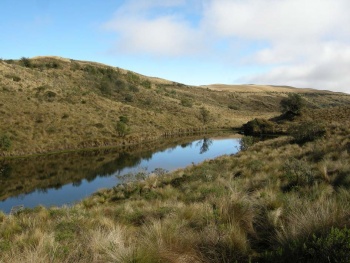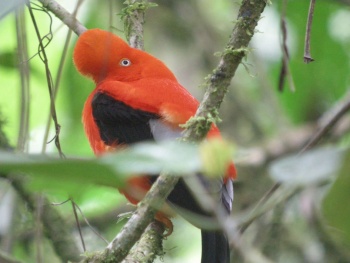Overview
The famous Manu Road goes from Paucartambo up to the Acjanaco Pass (3550m) and from there in countless bends down the Kosnipata valley to the Amazonian lowland. It passes from the high Andean grassland through pristine Cloud Forest, hill forest and some agricultural areas to the Alto Madre de Dios river at Atalaya. The road ends there and transport down to Boca Manu and further downriver is only possible by boat.
It is worth to spend several days in the area and to spend some time at each altitudinal zone. Most birders visit the area with organised trips, however it is possible to travel here indepently.
Birds
Notable Species
Hundreds of species can be found along the Manu road, Hummingbirds, Tanagers, Flycatchers, Cotingas, Quetzals and much, much more.
Andean Cock-of-the-rock is usually on the wish-list and is easy to see. Military Macaw can be seen as well and Montane Solitary Eagle should be seen during a stay of several days.
Check-list
Birds you can see here include:
Hooded Tinamou, Brown Tinamou, Speckled Chachalaca, Andean Guan, Rufous-breasted Wood Quail, Black Vulture, Turkey Vulture, Greater Yellow-headed Vulture, King Vulture, Swallow-tailed Kite, Double-toothed Kite, Plumbeous Kite, Cinereous Harrier, Crane Hawk, Montane Solitary Eagle, Roadside Hawk, White-throated Hawk, Black-and-white Hawk-Eagle, Black-and-chestnut Eagle, Mountain Caracara, Laughing Falcon, Barred Forest Falcon, Plumbeous Pigeon, Ruddy Ground-Dove, Gray-fronted Dove, Military Macaw, Chestnut-fronted Macaw, White-eyed Parakeet, Andean Parakeet, Scaly-naped Amazon, Squirrel Cuckoo, Smooth-billed Ani, Rufescent Screech Owl, Rufous-banded Owl, Andean Potoo, Rufous-bellied Nighthawk, Swallow-tailed Nightjar, Lyre-tailed Nightjar, Chestnut-collared Swift, White-collared Swift, Neotropical Palm Swift, Green Hermit, Green-fronted Lancebill, Lesser Violetear, Sparkling Violet-ear, Wire-crested Thorntail, Many-spotted Hummingbird, Speckled Hummingbird, Violet-fronted Brilliant, Giant Hummingbird, Shining Sunbeam, Great Sapphirewing, Bronzy Inca, Gould's Inca, Violet-throated Starfrontlet, Chestnut-breasted Coronet, Amethyst-throated Sunangel, Buff-thighed Puffleg, Rufous-booted Racket-tail, Scaled Metaltail, Tyrian Metaltail, Rufous-capped Thornbill, Long-tailed Sylph, Geoffroy's Daggerbill, White-bellied Woodstar, Crested Quetzal, Golden-headed Quetzal, Collared Trogon, Masked Trogon, Blue-crowned Trogon, Black-streaked Puffbird, Versicolored Barbet, Chestnut-eared Aracari, Gray-breasted Mountain Toucan, Golden-olive Woodpecker, Crimson-mantled Woodpecker, Yellow-tufted Woodpecker, Azara's Spinetail, Ash-browed Spinetail, Marcapata Spinetail, Scribble-tailed Canastero, Spotted Barbtail, Pearled Treerunner, Montane Foliage-gleaner, Striped Treehunter, Ochre-throated Foliage-gleaner, Wedge-billed Woodcreeper, Olive-backed Woodcreeper, Montane Woodcreeper, Red-billed Scythebill, Chestnut-backed Antshrike, Variable Antshrike, Stripe-chested Antwren, Ornate Stipplethroat, Yellow-breasted Antwren, Black Antbird, Western Fire-eye, Yellow-breasted Warbling Antbird, Rufous-breasted Antthrush, Barred Antthrush, Scaled Antpitta, Red-and-white Antpitta, Urubamba Antpitta, Slaty Gnateater, Trilling Tapaculo, White-crowned Tapaculo, Puna Tapaculo, Streak-necked Flycatcher, Inca Flycatcher, Slaty-capped Flycatcher, Black-backed Tody-Flycatcher, Black-throated Tody-Tyrant, Bolivian Tyrannulet, White-crested Elaenia, White-throated Tyrannulet, White-banded Tyrannulet, Torrent Tyrannulet, Marble-faced Bristle-Tyrant, Cinnamon-faced Tyrannulet, Scale-crested Pygmy-Tyrant, Olive-faced Flatbill, Handsome Flycatcher, Cinnamon Flycatcher, Smoke-colored Pewee, Black Phoebe, Maroon-belted Chat-Tyrant, Rufous-breasted Chat-Tyrant, Brown-backed Chat-Tyrant, Streak-throated Bush-Tyrant, Dusky-capped Flycatcher, Tropical Kingbird, Lemon-browed Flycatcher, Golden-crowned Flycatcher, Social Flycatcher, Red-crested Cotinga, Barred Fruiteater, Plum-throated Cotinga, Amazonian Umbrellabird, Andean Cock-of-the-rock, Yungas Manakin, Barred Becard, Red-eyed Vireo, Brown-capped Vireo, White-collared Jay, Violaceous Jay, Inca Jay, Brown-bellied Swallow, Blue-and-white Swallow, Southern Rough-winged Swallow, Fulvous Wren, Grass Wren, House Wren, Mountain Wren, Gray-breasted Wood Wren, Southern Nightingale-Wren, Chestnut-breasted Wren, Andean Solitaire, White-eared Solitaire, Chiguanco Thrush, Great Thrush, Glossy-black Thrush, Speckled Nightingale-Thrush, Paramo Pipit, Bronze-green Euphonia, Orange-bellied Euphonia, Blue-naped Chlorophonia, Hooded Siskin, Olivaceous Siskin, Tropical Parula, Slate-throated Whitestart, Spectacled Whitestart, Two-banded Warbler, Cuzco Warbler, Citrine Warbler, Three-striped Warbler, Crested Oropendola, Dusky-green Oropendola, Russet-backed Oropendola, Rufous-collared Sparrow, Gray-eared Brush-Finch, Olive Finch, Magpie Tanager, Grass-green Tanager, Common Chlorospingus, Short-billed Chlorospingus, Yellow-throated Chlorospingus, White-browed Hemispingus, Superciliaried Hemispingus, Black-eared Hemispingus, Rust-and-yellow Tanager, Slaty Tanager, Silver-beaked Tanager, Blue-gray Tanager, Blue-capped Tanager, Blue-and-yellow Tanager, Hooded Mountain Tanager, Scarlet-bellied Mountain Tanager, Blue-winged Mountain Tanager, Yellow-throated Tanager, Golden-collared Tanager, Chestnut-bellied Mountain Tanager, Orange-eared Tanager, Paradise Tanager, Golden Tanager, Saffron-crowned Tanager, Golden-eared Tanager, Spotted Tanager, Bay-headed Tanager, Blue-necked Tanager, Beryl-spangled Tanager, Blue-and-black Tanager, Swallow Tanager, Black-throated Flowerpiercer, Moustached Flowerpiercer, Golden-eyed Flowerpiercer, Masked Flowerpiercer, Blue-backed Conebill, Capped Conebill, Golden-collared Honeycreeper, Ash-breasted Sierra Finch
Other Wildlife
Tufted Capuchin Monkey and Gray Wooly Monkey roam around in the trees. South American Coati can be seen on the road. At the feeder at Cock-of-the-rock Lodge Tayra is regularly seen and Brown Agouti come to feed too. Montane Guinea Pig live around the pass and Bolivian Squirrel lower down in the forest.
Site Information
History and Use
The unpaved road links the Andean highland with the Amazonian lowland. There is not very much traffic, so birding along the road is mostly easy.
Landslides regularly cut the road and in most areas it is highly advisable to stay on the road and not to try to walk off the road. The slopes are very steep.
Areas of Interest
It is worth to spend some time in each altitudinal zone.
- Acjanaco pass (3550m)
- Grassland with some bushes hold Puna Tapaculo, Paramo Pipit, Great Sapphirewing, Scribble-tailed Canastero and Urubamba Antpitta (a good place is just below the pass towards Wayquecha).
- Wayqecha Cloud Forest Biological Station (3000m)
- Around Wayqecha Andean Guan, many Hummingbirds, Marcapata Spinetail, Puna Thistletail, Swallow-tailed Nightjar, Rufous-breasted Chat-Tyrant, Brown-backed Chat-Tyrant and various Mountain Tanagers and Flowerpiercers are found here.
- Tunnel area
- Here the road passes two tunnels and some bridges
- Pillahuata Waterfall (2300m)
- Red-and-white Antpitta and Handsome Flycatcher are some of the most interesting species here.
- Lookout (2000m)
- The lookout above the lodges gives you a fabulous panorama of the Kosnipata valley.
- Around Cock-of-the-rock Lodge (1600m)
- Andean Cock-of-the-rock occurs here and some lodges have fenced areas with leks where you can watch the males displaying after paying an entrance fee. There is also a forest walk at the lodge (with a fee). Tanagers are plentiful here. Military Macaws can be seen flying over. All lodges have feeders for hummingbirds and some also for tanagers and other birds.
- Tanager bend (San Pedro)
- Below the lodges lies the famous Tanager bend where a new species of Tanager has been discovered, still awaiting formal description and for now called San Pedro Tanager.
- Quitacalzones / 1000m bridge (1100m)
- Olive Finch can be found here.
- Lowland before Pillcopata (>500m)
- Open areas between the villages hold different birdlife. The endemic Black-backed Tody-Flycatcher can be found here.
Access and Facilities
Busses from Cusco and Paucartambo run regularly to Pillcopata, sometimes further to Atalaya or even Ithahuania. It is also possible to hitchhike along the road.
There are basic hotels in Paucartambo and Pillcopata and several lodges along the road (Manu Cloud Forest Lodge, Paradise Lodge, Cock-of-the-rock Lodge and some small lodges before Pillcopata). It might also be possible to spend the night at Wayqecha Cloud Forest Biological Station. As many lodges are often full with groups it is best to reserve an accomodation. Many lodges also organize transport from Cusco to the lodge.







